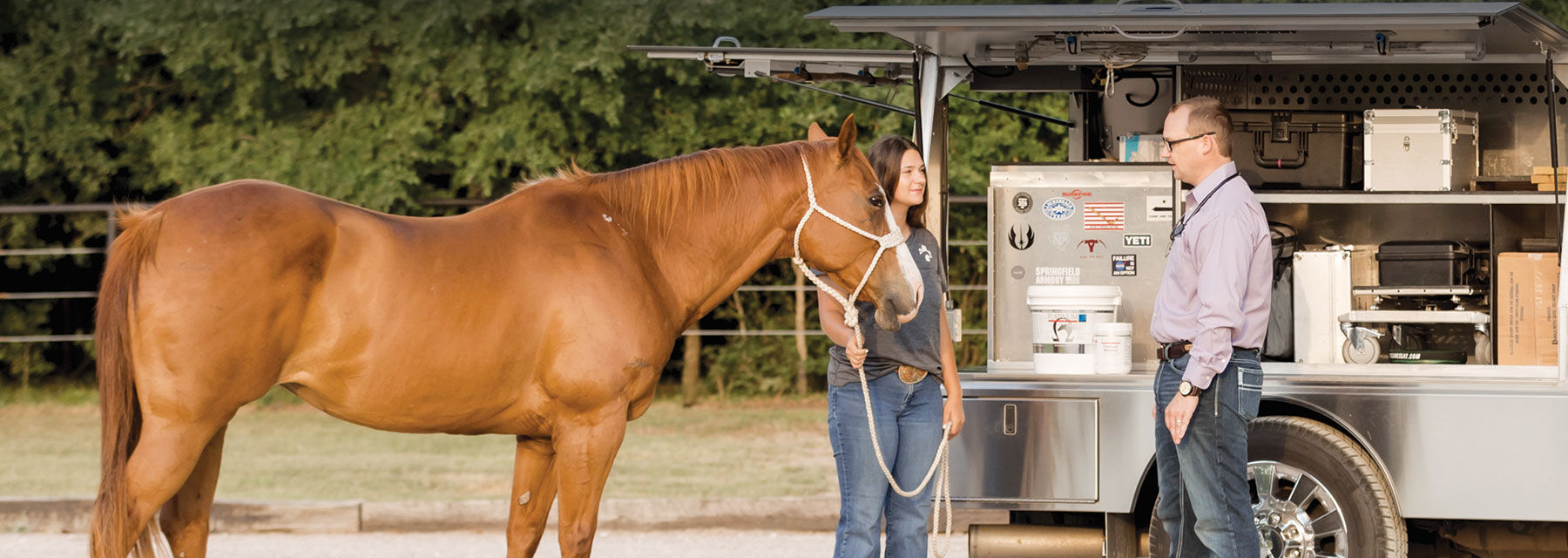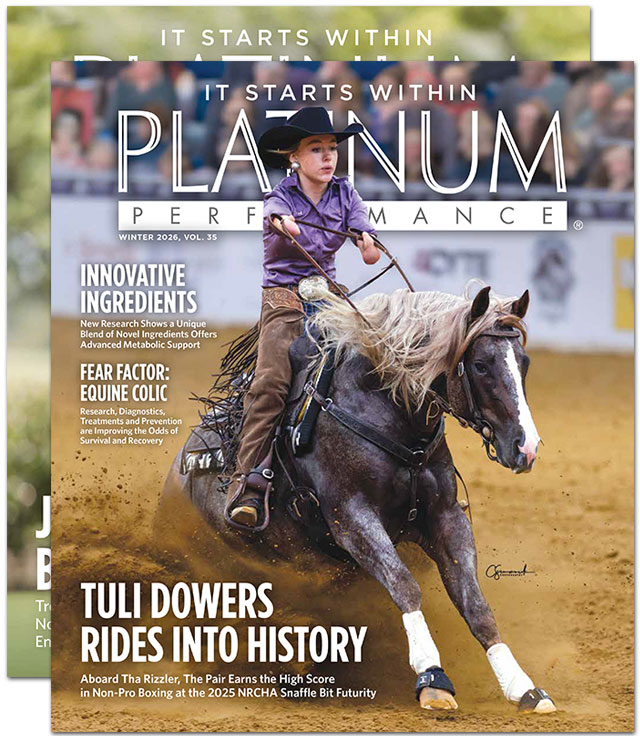Causes, Symptoms and Management of a Gene Mutation that Causes This Muscle Disorder
Hyperkalemic periodic paralysis is an inherited neuromuscular disease afflicting nearly one in 20 Quarter Horses. HYPP is caused by a point mutation in the sodium channel gene of affected horses that causes episodes of muscle weakness or paralysis from elevated potassium levels in the blood. This disorder traces back to Impressive, the American Quarter Horse Association’s 1974 World Champion Open Aged halter horse. Confirmed HYPP cases are limited to this sire’s descendants, a byproduct of wildly popular breeding to Impressive in the 1980s and early ‘90s for his standout conformation and coveted heavy muscling. This sorrel stallion left his mark on the industry having sired 2,251 foals with over 355,000 descendants registered with the AQHA — an estimated 4.4% of Quarter Horses, along with closely related breeds like American Paint Horses and Appaloosas.
HYPP is not curable, but most horses with the condition can lead normal lives with proper management depending on the frequency and severity of episodes. Horse owners and breeders must remain vigilant and proactive, ensuring afflicted horses receive the necessary care, nutrition, monitoring and veterinary care to thrive. Dietary strategies and exercise programs are essential to maintaining the animal’s performance and health. Advances in genetic testing have made it easier to identify carriers.
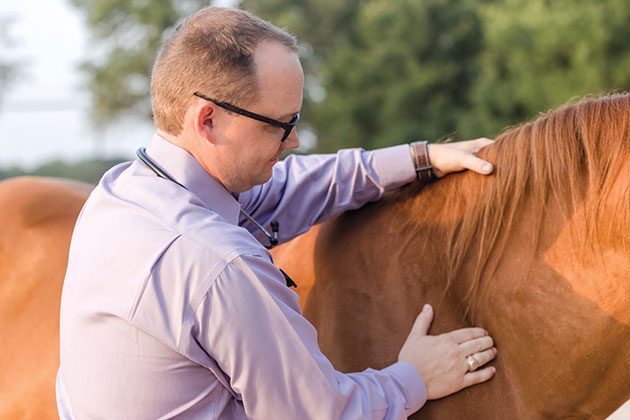
What is Hyperkalemia?
Hyperkalemia is an excessive amount of potassium in the blood. In HYPP horses, excessive blood potassium causes the muscles to contract more easily, making the horse susceptible to sporadic episodes of tremors, weakness or paralysis.
Causes
The underlying cellular cause of an HYPP episode, or attack, is a genetic mutation, specifically a sequence substitution of the amino acids phenylalanine by leucine in the SCN4A gene. This affects the sodium channel in skeletal muscle cells. These specialized gateways or “pores” are responsible for transporting sodium and conducting electrical signals that cause muscle contraction. In HYPP horses, sodium channels are defective and unable to close once opened. This results in a persistent trickle of sodium ions into the muscle cells. As intracellular sodium levels rise, cells push out potassium into the blood to maintain the correct concentration and electrical gradient between the outside and the inside of the cell. High blood potassium (hyperkalemia) disrupts the electrical activity in muscles and nerves cause muscle cells to excite, leading to involuntary contractions. As potassium builds up, the horse's muscles can spasm and become weak or stiff. In severe cases, muscles lock up, resulting in paralysis, particularly in the limbs.
In affected horses, this vicious cycle continues until the excessive potassium can be excreted through the urine or reabsorbed into cells.
Common risk factors include diet and feeding changes, fasting, exercise restriction, anesthesia or heavy sedation and stress. Stress frequently triggers an episode, and it is not uncommon for the afflicted horses to only show signs during stressful events, such as transport, competitions, veterinary procedures, farrier visits, a significant change in environment or concurrent illness. Weaning can cause an attack in foals. Lastly, general anesthesia can precede an episode, so veterinarians should be alerted to HYPP status before procedures. Keeping a consistent daily routine and taking care to avoid stressful situations can also be helpful.
What Happens in a Normal Muscle Cell vs. an HYPP Muscle Cell?
| Factor | Normal | Hypp |
|---|---|---|
| Sodium Channel | Opens and closes normally | Leaks and stays open |
| Potassium | Normal levels | Lowered (lost to the blood) |
| Membrane Potential | Stable | Unstable (easily depolarized) |
| Muscle Function | Controlled contractions | Spasms, stiffness or paralysis |
“The diet is the most important management piece for horses with HYPP. Sometimes when we say nutrition, some people skip immediately to just the grain or the hay or the supplements, but it is really all of those. Everything combined adds up to total daily percentages and nutrient levels.”
— Joe Pluhar, DVM, MBA, Freedom Equine Performance, Navasota, Texas
Clinical Signs and Episode Treatments
Each horse is unique with some showing no clinical symptoms throughout their entire lives while others have varying degrees of episodes, from daily muscle tremors to significant weakness or even collapse. The majority of affected horses show intermittent signs around 2-3 years of age. Some horses can often go long periods without showing any signs between episodes.
An episode may occur rapidly and without notice ranging from mild to life-threatening. They typically last 15 to 60 minutes, and, afterward, it is not uncommon for horses to appear completely normal and walk with minimal to no gait change. As a result, an attack can be mistaken for a bout of colic, choking, tying up (exertional rhabdomyolysis) or a seizure. Although most HYPP episodes spontaneously self-recover, contact your veterinarian when episode symptoms are seen.
For a mild episode, light exercise or administering a high-sugar feed like corn syrup or a little grain can be helpful. The sugar stimulates insulin secretion, which moves potassium out of the blood and back into cells.
During a severe HYPP episode, muscles can paralyze to the point where the horse suddenly collapses. Muscles controlling breathing can immobilize leading to respiratory distress or heart failure, both potentially fatal conditions. During a severe or prolonged attack, emergency treatment from a veterinarian is necessary to reduce elevated potassium levels and restore normal muscle function.
Common Symptoms of a Mild to Moderate Episode:
- Muscle twitching (especially in the flanks, shoulders or face)
- Body tremors (shaking or trembling)
- Muscle stiffness or difficulty moving
- Weakness, especially in the hindquarters
- Cramping or tying up like symptoms
- Prolapse of the third eyelid
- Elevated heart rate
- Sweating
- Temporary paralysis, particularly of the limbs
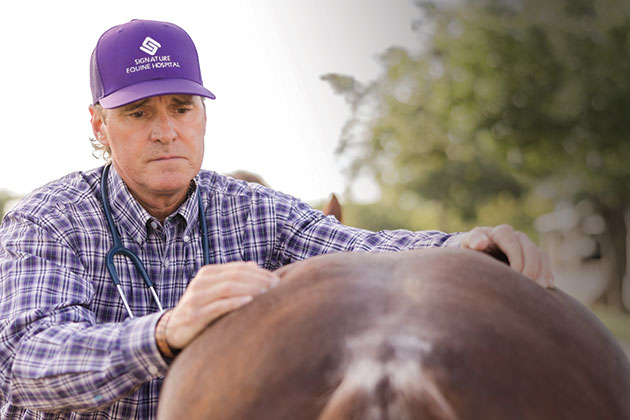
The disorder is autosomal dominant meaning a horse only needs to inherit one copy of the mutated gene to be affected, so it readily passes to subsequent generations. As an inherited condition, horses that never show HYPP symptoms are still genetic carriers and can have affected offspring.
The disorder is autosomal dominant meaning a horse only needs to inherit one copy of the mutated gene to be affected, so it readily passes to subsequent generations. As an inherited condition, horses that never show HYPP symptoms are still genetic carriers and can have affected offspring.
Diagnosis
HYPP was one of the first genetic disorders to be discovered in the horse. Genetic testing is available to identify the specific gene mutation and definitively diagnose HYPP. The DNA test is extremely specific and is accurate for the gene sequence substitution that causes the muscle disorder. Hair or blood can be used to test for the defective gene. Genetic tests also help elucidate the potential severity of the condition.
The disorder is autosomal dominant meaning a horse only needs to inherit one copy of the mutated gene to be affected, so it readily passes to subsequent generations. As an inherited condition, horses that never show HYPP symptoms are still genetic carriers and can have affected offspring.
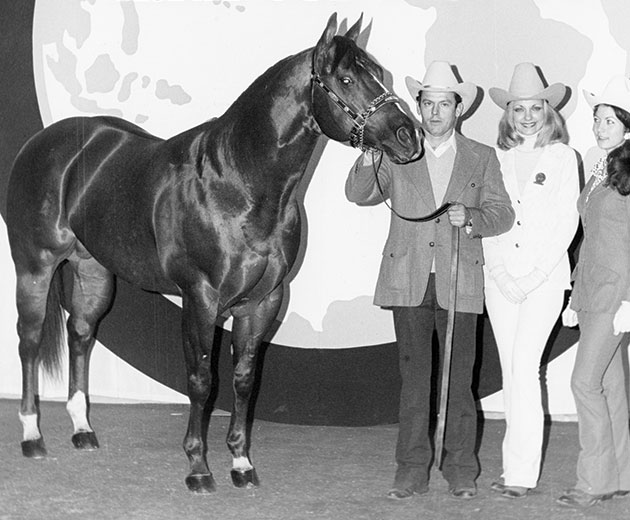
Impressive died in March 1995 at age 26. He was inducted into the American Quarter Horse Hall of Fame in 2022. “That said, the study of HYPP improved the understanding of muscle biology and other inheritable variants,” the AQHA said in his biography. “This was a stallion legendary in his own time, nearly unbeatable in the show ring, with progeny and later descendants dominating the halter horse world for more than four decades now.”
Once Tested, Horses Can be Designated with These Genotypes:
- H/H (Homozygous) - Affected: Horse possesses two copies of the HYPP gene mutation and is likely to experience symptoms (often severe) of the disorder. Horse will pass on the gene to all offspring.
- N/H (Heterozygous) - Affected: Horse possesses one copy of the HYPP gene mutation and is likely to experience some symptoms (usually milder) associated with the disorder. Horse has a 50% chance to pass on the gene to any offspring.
- N/N (Normal) - Horse does not carry the HYPP gene mutation.
Homozygous horses will be more severely affected compared to heterozygous offspring and require very specialized care and management for long-term survival. They are likely to suffer severe episodes. Those with heterozygous lineage are likely less affected by the disorder and may show milder to no symptoms. These horses can have a good quality of life and are less likely to have severe episodes.
Genetic testing is the only way to verify if the horse is a HYPP carrier. Responsible breeding is essential. The AQHA officially declared HYPP as an undesirable genetic defect nearly 20 years ago and established mandatory genetic testing for all foals born after Jan. 1, 1998, with bloodlines descending from Impressive. Additionally, the organization later ruled that homozygous foals born since 2007 with H/H test results are not eligible for registration.
Possible Veterinary Interventions to Abort a Severe Episode:
- Calcium gluconate: stabilizes heart and muscle cell membranes
- Dextrose: drives potassium back into cells
- Sodium bicarbonate: corrects acidosis and lowers potassium levels
- Epinephrine injection: stimulates the release of insulin to move potassium from the bloodstream back into cells
Managing Horses with HYPP
Diet
One of the most critical aspects of preventing attacks for a horse with HYPP is a managed diet centered around low-potassium feeds. Decreasing potassium, reduces fluctuations in the blood, making defective cells less prone to activation. Potassium is an abundant mineral in the typical equine diet, but it is possible to limit a horse’s intake. Ideally, horses with recurrent HYPP episodes should receive a balanced diet containing less than about 1% potassium. Horses exercising intensely may have a slightly increased requirement. Meals should each contain less than 33 grams of potassium. Industry experts recommend having all forages analyzed for potassium content. The horse shouldn’t fast for any prolonged amount of time.
Exercise
Light, regular exercise or frequent access to a large paddock is encouraged. While it’s logical to assume exercise may increase blood potassium concentrations and exacerbate HYPP symptoms, the opposite is actually true. Stall confinement is often not advised for affected horses. However, overexertion can be a trigger.
Medication
Acetazolamide or hydrochlorothiazide are diuretics and often prescribed to treat affected horses and help prevent the onset of episodes. Acetazolamide stabilizes blood glucose and potassium by stimulating insulin excretion. It is not uncommon for HYPP horses to receive these medications for long periods.
Every attending veterinarian should be alerted to an equine’s HYPP condition as anesthesia or heavy sedation can cause complications or precipitate an episode of paralysis.
Have on Hand
For mild episodes, keep Karo® Corn Syrup or light corn syrup in the barn and dose 2-4 ounces (60-120 mL) orally when early symptoms show. The syrup provides a quick source of glucose that stimulates insulin release and helps quickly drive the potassium back into cells to relieve muscle tremors and other symptoms.
“For horses affected with HYPP, you can’t be too cautious with their diet. Read the label, look at the analysis for everything they eat. Horse owners have to be vigilant about added potassium in feeds and supplements, especially electrolytes. You even have to be aware of the additives and the flavorings, like molassesor alfalfa-flavored medicines. I’ve had some horses that are sensitive to that.”
— Joe Pluhar, DVM, MBA, Freedom Equine Performance, Navasota, Texas
Considerations for Feeding Horses with HYPP
Horse Owners Need to Stay Vigilant to Avoid Added Potassium
High-potassium dietary levels strongly correlate with HYPP episodes. Horse owners should strive to feed a balanced diet containing 0.6% to 1.1% total potassium concentration and with single meals containing no more than 33 grams of potassium. Maintain a regular feeding schedule with several, small meals spread throughout the day. Avoid rapid feed changes, including forage. “The diet is the most important management piece for horses with HYPP,” says Dr. Joe Pluhar, a sports medicine veterinarian and active AQHA member who has treated numerous HYPP-affected horses at his practice, Freedom Equine Performance in Navasota, Texas, northwest of Houston. “Sometimes when we say nutrition, some people skip immediately to just the grain or the hay or the supplements, but it is really all of those. Everything combined adds up to total daily percentages and nutrient levels.”
Provide fresh, clean water at all times to avoid dehydration, which can exacerbate HYPP effects. Salt is essential for affected horses to encourage drinking and to flush potassium out of the body via urination. Provide white salt at all times — either loose or as a salt block. Avoid “lite” salt, as it’s a blend containing potassium chloride. Add 1-2 ounces of salt daily directly to their feed of an average-size adult horse — especially in hot, humid weather.
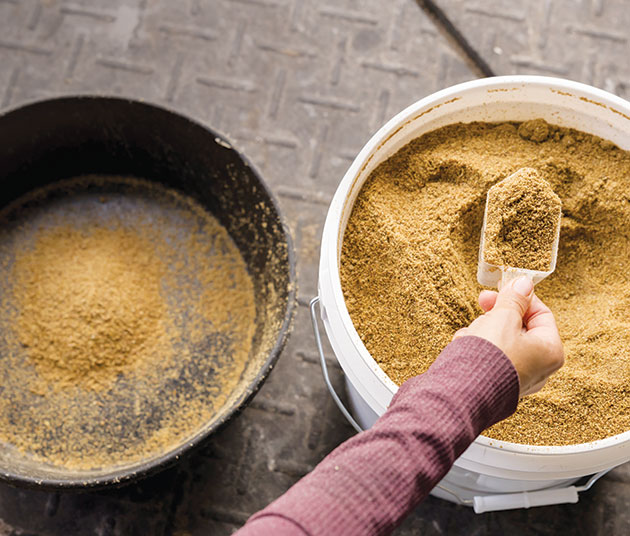
A comprehensive omega-3 fatty acid, antioxidant, vitamin and mineral supplement can be helpful to balance a forage-based diet.
A comprehensive omega-3 fatty acid, antioxidant, vitamin and mineral supplement can be helpful to balance a forage-based diet.
Calculating Potassium Levels in Feeds
Calculate the total grams of potassium per serving by multiplying the amount of feed by the percentage of potassium.
Example 1: How many grams of potassium are in Timothy hay that contains 1.5% potassium as fed? Your horse eats 10 pounds of hay per day.
Convert pounds to grams: 10 pounds x 454 grams = 4,540 grams
Change percent to decimal: 1.5 / 100 = 0.015
0.015 x 4,540 grams = 68.1 grams of potassium in 10 pounds of Timothy hay
Example 2: How many grams of potassium are in 2 pounds of whole oats? The oats are 0.51% potassium per pound.
Convert pounds to grams: 2 pounds x 454 grams = 908 grams
Change percent to decimal: 0.51 / 100 = 0.0051
0.0051 x 908 grams = 4.63 grams of potassium in 2 pounds of oats
Forages
Pasture and hay should be the foundation for all equine diets. For HYPP horses, forage choices narrow considerably as many hays and pasture grasses contain elevated potassium concentrations. Analyze all forage to determine potassium content as it varies significantly depending on plant type, maturity and soil content.
Pasture grazing for an HYPP horse is generally regarded as safe, and full 24/7 turnout is recommended to offer the most consistent dietary potassium levels. Fresh grass can be more than 80% water compared to hay. With an average of about 10% moisture content, potassium content is diluted in fresh grass, making it unlikely that a horse will consume large amounts of potassium in a short period. However, it is important to know if the pasture has plants, such as legumes (alfalfa and clover), that have higher potassium concentrations.
Timothy, Bermuda and prairie or meadow grass hays are often considered more suitable for HYPP horses. Hay cut at a later or more mature growth phase is preferred over early cut, immature hays of any type, which are higher in potassium. The mineral content of hays can vary widely, averaging 1-3% potassium on a dry matter basis. Soaking hay in cold water for 30-60 minutes can reduce its potassium content 30-65% making it more appropriate to feed. Discard water before feeding, however.
In general, alfalfa, orchard grass and brome hays should be fed sparingly, if at all, because they contain higher levels of potassium.
Concentrates
Horses with HYPP can be maintained on a forage-only diet with a vitamin and mineral supplement, or balancer, to fill nutritional gaps. If the horse cannot hold body condition on forage alone, include multiple, small meals of concentrated feed spaced evenly throughout the day. This reduces big insulin shifts and can maintain normal concentrations of circulating blood glucose and potassium levels.
Lower potassium concentrates are another option. These include plain grains — whole oats, wheat, corn and barley — that also have higher starch levels and should be fed with caution to horses with sugar sensitivities. Unmolassed beet pulp can be a good feed option as it is low in both potassium and sugar. Soaking beet pulp is recommended as the absorbed water will further dilute potassium levels. Healthy oils, like flaxseed oil, can be a useful calorie source that is low in potassium. It can be mixed with unmolassed beet pulp, a grass hay pellet or cube.
Finding a suitable commercial feed can be difficult, as potassium-rich soybean meal and molasses are widely used in formulations. Commercial feeds marketed for performance horses or broodmares often have higher added potassium. Check the feed tag or contact the feed company to verify potassium levels before feeding.
High-Potassium Feeds to Avoid
- Molasses
- Alfalfa hay, cubes or pellets
- Brome hay
- Orchard grass hay
- Soybean meal
- Electrolyte supplements
- “Lite” salt (a mix of sodium chloride and potassium chloride)
- Kelp-based supplements
- Treats, such as bananas and cantaloupe
Supplements
A comprehensive omega-3 fatty acid, antioxidant, vitamin and mineral supplement can be helpful to balance a forage- based diet.
Nutrients that support muscle function such as vitamin E and selenium can be supplemented to boost muscle health. Include at least 1,000 IU of natural vitamin E and 1 mg of selenium. Ensure calcium intake meets requirements to support normal functioning of sodium ion channels. Magnesium, an important mineral for muscle health, can help reduce the risk of symptoms associated with muscle weakness and tension. It is often deficient in equine diets and may need to be supplemented to meet daily needs.
Most electrolyte supplements are unsuitable due to the high levels of potassium. Check labels for the guaranteed analysis, or contact the manufacturer to ensure the formula is appropriate. “For horses affected with HYPP, you can’t be too cautious with their diet. Read the label, look at the analysis for everything they eat,” Dr Pluhar urges. “Horse owners have to be vigilant about added potassium in feeds and supplements, especially electrolytes. You even have to be aware of the additives and the flavorings, like molasses- or alfalfa-flavored medicines. I’ve had some horses that are sensitive to that.”
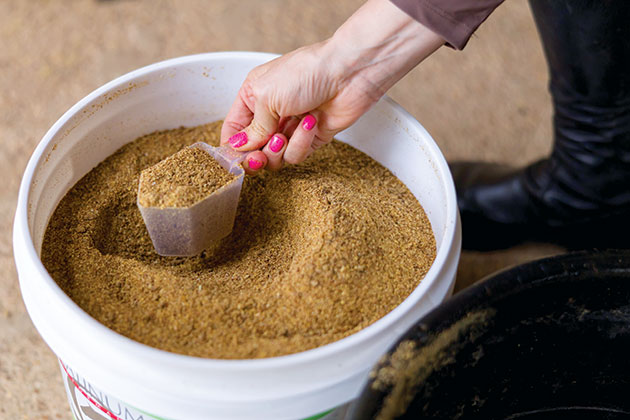
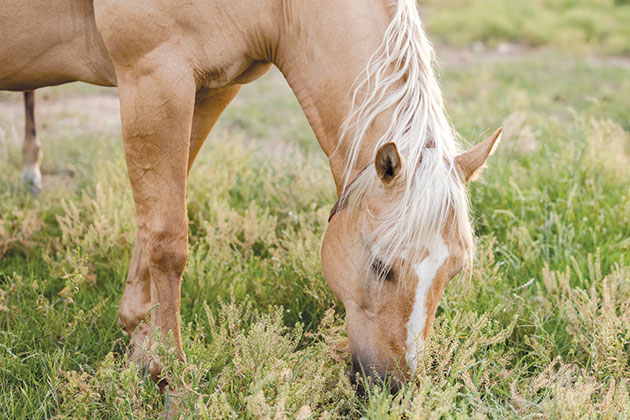
Can I Feed Platinum to My Horse with HYPP?
Yes, Platinum Performance® Wellness formulas are appropriate in a low-potassium diet. The range of products provide about 1.10 grams of potassium per 2 scoops (the recommended serving size for a 1,000-pound adult horse). Each Platinum Performance® Wellness formula provides a comprehensive blend of omega-3 fatty acids, antioxidants, vitamins and minerals to support a balanced, forage-based diet.
